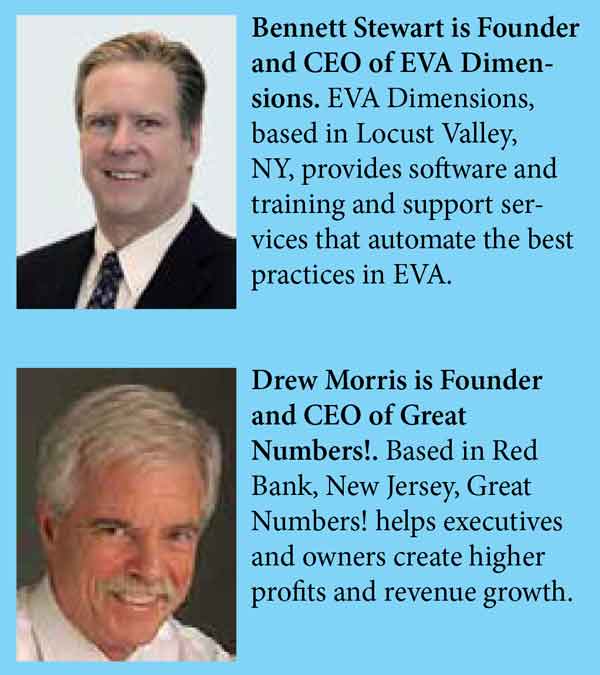
More than ever, CEOs have been under scrutiny. The public looks to business leaders to create new jobs, but to do that they have to generate real economic value—as opposed to mere accounting value as measured by GAAP metrics. Creating value is, after all, what CEOs are paid to do. But how should it be measured? For our seventh annual index, Chief Executive partnered with EVA Dimensions’ CEO Bennett Stewart and Great Numbers!’s CEO Drew Morris. We ranked the top 100 public companies of the S&P 500 where the CEO has been in place for at least three years (see p. 39). Similarly, we also ranked the top 40 mid-market companies (see p. 43) from the Russell 3000 in two tiers: upper mid-market companies with revenues between $500 million and $1 billion, and a lower mid-market tier of companies with revenues between $100 million and $500 million.
While there is no single measure that is perfect, we relied on two key underlying metrics:
 MVA, or market value added, is the spread between a firm’s overall market value and the total capital that’s been invested in its net business assets. It is the value added to, or deducted from, the owner’s investment in the business. It equals the owners’ wealth, measures the firm’s franchise value, and represents its aggregate NPV (net present value). Increasing MVA is the key to creating wealth and driving total shareholder return.
MVA, or market value added, is the spread between a firm’s overall market value and the total capital that’s been invested in its net business assets. It is the value added to, or deducted from, the owner’s investment in the business. It equals the owners’ wealth, measures the firm’s franchise value, and represents its aggregate NPV (net present value). Increasing MVA is the key to creating wealth and driving total shareholder return.
EVA, or economic value added, measures a firm’s economic profit—it is profit after subtracting a full, weighted average cost of capital, and after correcting accounting distortions. EVA increases when costs are cut, assets are managed judiciously, and when management invests new capital, including R&D and ad spending, to profitably grow the business over the full cost of the capital.
Chief Executive Group exists to improve the performance of U.S. CEOs, senior executives and public-company directors, helping you grow your companies, build your communities and strengthen society. Learn more at chiefexecutivegroup.com.
0

1:00 - 5:00 pm
Over 70% of Executives Surveyed Agree: Many Strategic Planning Efforts Lack Systematic Approach Tips for Enhancing Your Strategic Planning Process
Executives expressed frustration with their current strategic planning process. Issues include:
Steve Rutan and Denise Harrison have put together an afternoon workshop that will provide the tools you need to address these concerns. They have worked with hundreds of executives to develop a systematic approach that will enable your team to make better decisions during strategic planning. Steve and Denise will walk you through exercises for prioritizing your lists and steps that will reset and reinvigorate your process. This will be a hands-on workshop that will enable you to think about your business as you use the tools that are being presented. If you are ready for a Strategic Planning tune-up, select this workshop in your registration form. The additional fee of $695 will be added to your total.

2:00 - 5:00 pm
Female leaders face the same issues all leaders do, but they often face additional challenges too. In this peer session, we will facilitate a discussion of best practices and how to overcome common barriers to help women leaders be more effective within and outside their organizations.
Limited space available.

10:30 - 5:00 pm
General’s Retreat at Hermitage Golf Course
Sponsored by UBS
General’s Retreat, built in 1986 with architect Gary Roger Baird, has been voted the “Best Golf Course in Nashville” and is a “must play” when visiting the Nashville, Tennessee area. With the beautiful setting along the Cumberland River, golfers of all capabilities will thoroughly enjoy the golf, scenery and hospitality.
The golf outing fee includes transportation to and from the hotel, greens/cart fees, use of practice facilities, and boxed lunch. The bus will leave the hotel at 10:30 am for a noon shotgun start and return to the hotel after the cocktail reception following the completion of the round.